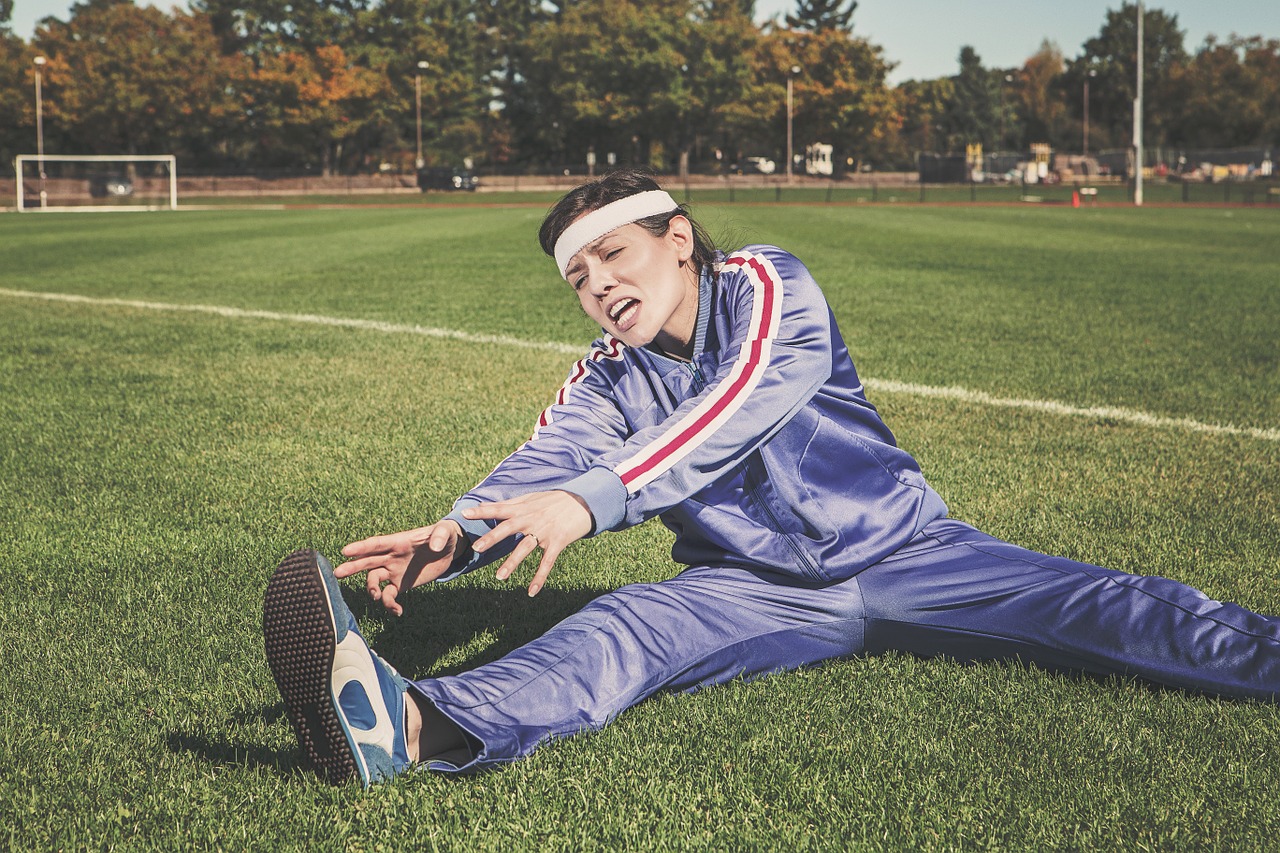The general consensus for years has been that, when a muscle is tight, it should be stretched. It makes sense, right? If a hamstring or piriformis is tight, and stretching loosens muscles, then why wouldn’t you stretch it?
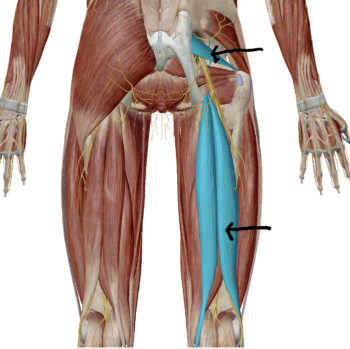 There is no doubt that piriformis and hamstring stretches are very popular with athletes, sedentary workers, physical therapists, trainers, and chiropractors. These stretches undoubtedly can give some short-term relief to achy and stiff muscles, but should they be widely used? Can you overuse them? When should you avoid these stretches? What benefit do the stretches actually provide, and are there any alternatives to them?
There is no doubt that piriformis and hamstring stretches are very popular with athletes, sedentary workers, physical therapists, trainers, and chiropractors. These stretches undoubtedly can give some short-term relief to achy and stiff muscles, but should they be widely used? Can you overuse them? When should you avoid these stretches? What benefit do the stretches actually provide, and are there any alternatives to them?
The vast majority of people stretch with the false hope of eliminating muscle soreness, improving athletic performance, or preventing injuries. Sadly, the science does NOT tell us that one can achieve any of these results. Rather, the exact OPPOSITE is often true.
Myth Busting
- Eliminating Soreness
Stretching a muscle that is already sore from exercise causes additional trauma to the muscle, thereby slowing the healing process. The stretch pulls apart the fiber connections and re-traumatizes the muscle, prolonging recovery.
- Improving Athletic Performance
Stretching muscles prior to activity “loosens” them up, also known as decreasing muscle tone. When muscle tone decreases, they are less able to generate force, so performance decreases.
- Injury Prevention
Loosened muscles can no longer keep the joint(s) they interact with as tight (safe from moving improperly), thereby increasing injury opportunity.
**Case Study Example: When a person is running uphill, the piriformis and hamstring are used to provide a powerful contraction to move the body up the steep grade. At the same time, these muscles provide stability for the hip and knee posteriorly and laterally. Stretching these muscles prior to this activity will decrease the contraction and destabilize the joints, so don’t stretch the piriformis or hamstring if you want to run faster and keep these joints healthy.
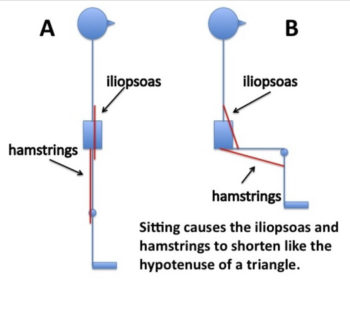 Long periods of sitting are to blame.
Long periods of sitting are to blame.
For simplicity, let’s think about the pelvis being pulled by two strings, one attached to the posterior side of the pelvis and one to the anterior. The anterior side (your front) becomes short, because of excessive periods of sitting, the posterior side (your backside) becomes under stretch. The pelvis becomes tilted forward and the hamstrings become the victim rather than the cause.
So what does this mean to your average office worker? Quite simply, when you sit down in your desk chair, you’re effectively resting your body in a way that it’s all folded up. Picture yourself sitting down in a chair, and then mentally remove the chair. Your knees are halfway to your chest – causing your hips to become tight – and your hamstrings are constantly sitting in a state of being half-stretched all the time.
In this situation, trying to stretch your hamstrings isn’t going to help the problem. Instead, it will simply further lengthen the tissue. You may experience some relief from stretching (similar to when you stretch your lumbar spine), but you aren’t reaching the actual problem. The relief will only be temporary. Once it passes, you will feel like you need to stretch the hamstrings again and again. This means that, instead of stretching the hamstrings, you should actually be working on strengthening them so they can counteract the anterior pelvic tilt position while also working to mobilize the anterior hip.
Instead of Stretching
First, change your position. The tightness you are feeling is most likely due to your muscles being in an over lengthened (stretched too far) position throughout the day. Your hip muscles feel “tight” when you have been on the couch, in the car, at your work desk, sleeping in the fetal position, and on the toilet for too long. In effect, when you are sitting, you are statically stretching the top half of the hamstring and the piriformis. This “tightness” feeling is often referred to as “neurological tightness.” The best way I can explain this is by thinking of a rubber band. Stretch it as far as you can and the band itself becomes taut. This is exactly what happens to certain muscles in our body particularly with any prolonged position (hamstrings, trapezius, cervical erector spinae, glutes, and rhomboids).
First, try Tripod Squats anytime you need a good change of position.
Stand with your feet flat on the floor, shoulder width apart. Bend forward and put your hands on the floor in front of your feet. From there sit back into your hips approximating your hips to your feet. Your hands will come off of the floor, but keep your arms extended in front of you. From this position stand back upright. Repeat up to seven times. For a demonstration of this exercise, see our Desk Exercises Video.
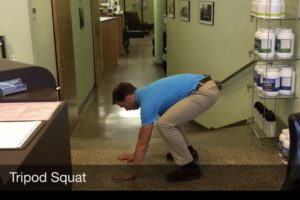 |
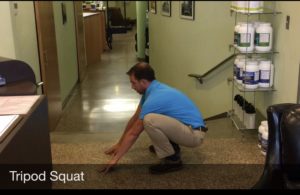 |
|---|---|
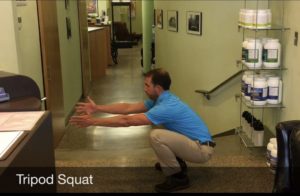 |
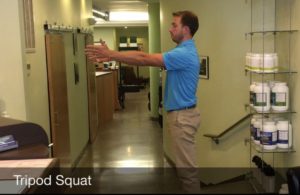 |
Second, look to strengthen the hamstrings and piriformis muscles with these functional hip exercises.
- Dumbbell Split Squats
Pick up a relatively light dumbbell and take a large step forward, as if you were to do a lunge. Then, supporting the weight under your chin, lower yourself down with control, making sure to keep yourself stable and aligned, with your eyes pointing forward.
The split squat is an exercise that should be used in a structural balance phase as it improves ankle mobility and lengthens the hip flexors. Increasing length through your hip flexors will reduce an anterior tilt and decrease the tension placed on the hamstrings. Check out this video for details: https://www.youtube.com/watch?v=RiFh2iPzuPo
- The Lunge Stretch
Place one knee down on the ground and the other foot out in front. The foot should be in front of the forward knee. Lunge through the hip, keeping your chest back during the stretch. The lunge stretch is a great exercise to perform after you have been sitting for longer than 30 minutes or before any workout. This stretch is detailed in our low-back pain exercise video: https://www.youtube.com/watch?v=f8XoIoiMmA4
- Foam Roll the Hamstrings
Foam rolling the hamstrings can be a great alternative to stretching the hamstrings. Foam rolling can improve blood flow to the muscle after prolonged sitting and reduce lactic acid build up after exercise. Try this video for a good tutorial: https://www.youtube.com/watch?v=7fEM1w_BuJk
- Kettlebell Swings
The kettlebell swing can be a great tool for strengthening the posterior chain including the hamstrings. This exercise is very functional as it grooves the hip hinge motion pattern used during walking, sit to stand, climbing stairs, and other similar movements. Here is a great video describing the kettlebell swing, https://www.youtube.com/watch?v=GYHbu2LRqD0&t=38s
- Foundation Training
Foundation training is an exercise program designed to strengthen and coordinate the muscles of the posterior chain. This chain includes the calves, hamstrings, glutes, and spinal erector muscles. Foundation training is an effective tool for improving posture and athletic performance and for decreasing back pain. Follow this link to a good introduction to foundation training: https://www.youtube.com/watch?v=vOgxWp0WyiI
If you have questions on this topic, feel free to post them on our Facebook page or ask us the next time you are in the office.

Daryl C. Rich, D.C., C.S.C.S.

